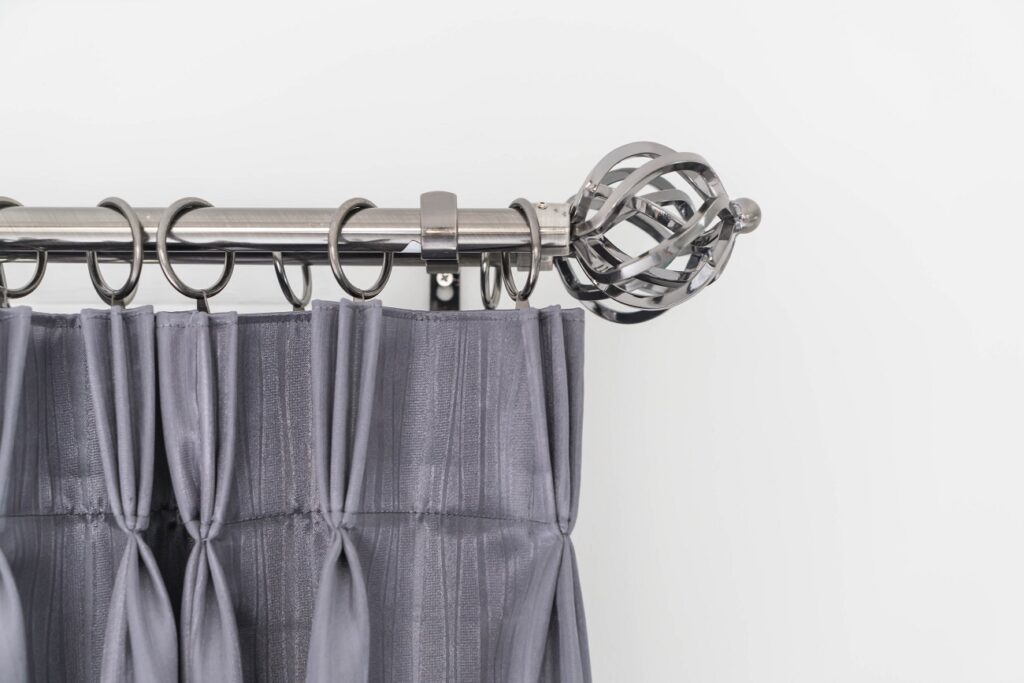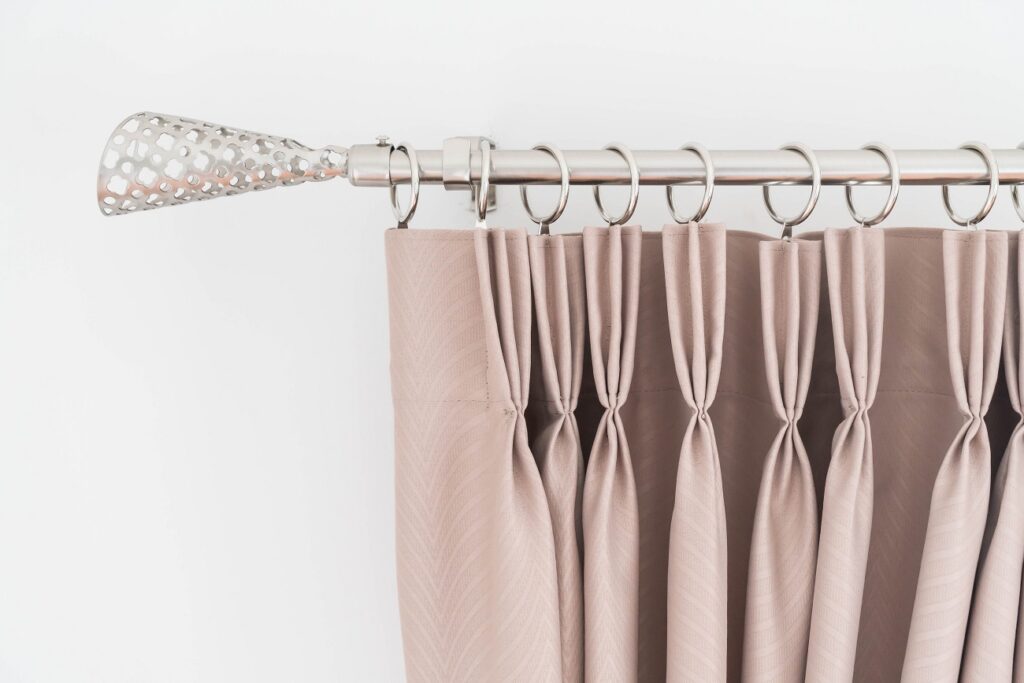Curtains are vital to a home’s interiors – both aesthetically and functionally. They offer privacy, protect you from the sun’s harsh rays, regulate temperatures, and help to tie together a space’s interior design. Additionally, you can choose the curtains and drapes’ individual components based on your preferences, desired purpose, and budget. This article will explore one of the many parts of window treatments – curtain finials.
But first, let’s look at finials in general and from where they come.
What are the Finials?

According to the dictionary definition, finials are a relatively small, ornamental, terminal feature at the top of a gable, pinnacle, etc. These decorative elements are used on the highest point of buildings, lamps and other light fixtures, fence posts, bedposts, stairways, etc. They are even placed on the ends of curtain poles known as curtain finials. They serve both functional and decorative roles.
Outdoor finials made of copper, brass, wrought iron and stone whereas indoor finials made of more delicate materials like glass or ceramic.
What are the Curtain Finials?

Curtain rod finials are a part of a curtain’s hardware that goes on the ends of a drapery rod. They complete window treatment and usually come with most ready-made curtain sets. In some cases, finials are part of the rod and act as an extension of the curtain hardware. They can be simple or fancy, made with metal, wood, plastic, etc. Most curtain finials act as a stylish element, their purpose is more than decorative.
A Brief Sneak-Peak into the History of Finials
It is believed that finials were a solution to gaps formed between tiles atop rounded roofs. They were often made with heavy materials such as stone and metal to weigh down and keep the tiles in place. As finials were in a prominent location atop the buildings, builders made them more decorative to make them pleasing to the eye.

While it is unclear exactly when finials first came into use in human architecture, the first prominent appearance was around 700 AD in Asian cultures. Buddhism influenced the design of these finials, so the lotus bud was the most common finial design. They were placed on large buildings built around heavily ornamented staircases and pagodas. While these finials were made of stone, the Japanese began making them out of metals like copper and iron and incorporated religious symbolism.
Finials were also found on ancient buildings of the Greeks and Romans. They saw a massive interest during the rise of Gothic and Renaissance architecture. In the case of the Gothic style, finials were made in the form of dragons, gargoyles, and other mythical creatures. Early Renaissance work saw finials take the form of candelabrum shafts.
Regal designs like the spike, ball, and fleur-de-lis came into use during the Victorian era.
The Gothic and Victorian styles heavily influenced the finials of the modern era, and many houses still use them to achieve a finished look. They can be grand or subdued.
Over the years, finials began appearing in other places like fence posts, on top of lamps, bedposts, and light fixtures, and at the ends of curtain poles.
What is the Purpose of Curtain Rod Finials?
- Prevents Curtains from Slipping Off: Once you fix the finials at the ends of your curtain pole, they create a secure zone after the end brackets. So your anchor curtain rings don’t fall off.
- Decorative Element: Most curtain rod finials look bold and decorative; even the simpler ones have a charm of their own. They give your window treatments a finished look.
- Plugs the Ends of Your Curtain Poles: Generally, curtain rods are hollow. So there might be chance of home for dust, spiders, and insects if not fitted with finials.
- Connect Window Treatments with the Interior Design: Match or contrast your window coverings, depending on your preference, with the rest of the furniture and fixtures or theme of the room with the appropriate finials.
Types of Curtain Rod Finials
Curtain finials come in different styles, materials, shapes and designs. They can be broadly classified as the following:
1. Metal Curtain Finials: As the name suggests, these finials are made of metal. The most common metals used to make finials are copper, wrought iron, chrome, and brass. Their look depends on the finishing of the design, so they don’t need to be painted. They are available in many shapes and designs.

You can opt for metal finials for curtain rods with most curtain styles.
2. Wood Curtain Finials: These curtain finials are made of wood and can come in different shapes and designs. You can finish their look with wood stain or polish or a nice coat of paint that matches the rest of the room.

3. Glass and Crystal Curtain Finials: These finials are made of glass or crystal, are paired with wooden or metal curtain rods.

4. Fused and Detachable Curtain Finials: These are not official terms but can generally be termed as such based on whether or not you can remove them. You can detach most finials from the curtain rods. However, some curtain poles continue into finials and look like a scroll.
5. Solid Shape: These are solid objects carved into different shapes. The typical curtain rod finials shapes are the fleur-de-lis, arrowhead, ball, square, etc. They can be made of wood or metal.

6. Open-Work Carvings: These finials are carved to create open spaces in the center. They can be metal or wood and are often paired with minimalistic or velvet curtains as they are very eye-catching.

How are Curtain Finials Different from End Caps and Finial Plugs?
Finials are decorative objects placed on the ends of curtain poles to give them a finished look and keep the curtains from slipping off. Most curtain rod finials are catchy and attractive and add character to the window treatment.
Compared to finials, curtain end caps are much smaller and simpler. They are often used in rooms that require a more modern and sleek look. End caps are also used when ordinary finials are too big to fit. Their only purpose is to give the rods a finished appearance and not draw any attention. Additionally, unlike finials, end caps are also used on the ends of window blinds.
Curtain rod finial plugs are plastic ends to help screw on a finial or end cap. They are not meant to be decorative objects and are hidden from view once the finial or end cap is in place.
How to Choose the Right Finial for Your Curtain Rod?
If you are planning to buy curtain finials to enhance the beauty and functionality of your home, then there are a few things you need to consider which include its material, colour and finishing. Remember the following points:
- Choose a material that will match with your curtain rods. Most of the curtain rods come in metal, wood, brass and nickel material.
- Finials and curtains rods available in variety of colours and finishing touches. So you can customize accordingly so that both complement each other. Apart from colour options, you need to think about the finial designs or style because they balance the overall look of your curtain rod and hardware.
When are Curtain Finials Not Necessary?

Curtain rod finials are not necessary when you add valances or pelmets. Valances and pelmets hide the end where curtain and drapery hardware are joined together, so you don’t have to invest in anything too fancy. You can use simple end caps to close the ends of the pole.
Finials are also not required when the ends of your curtain rod are fixed directly to the wall or when you use tension rods.
Conclusion
Curtain finials have a rich history and are relevant even in modern interior design. You can be sure that they will continue to be used in the future. If you feel like your curtain rods look too simple, go ahead and buy finials that will complement and improve the look of your window treatment.
If you want to read similar article, then refer following link:
8 Curtain Tie Back Ideas: Different Ways To Tie Back Curtains
Author Bio
Andrea Noronha – Andrea Noronha is a content writer and editor with over 4 years of experience. Although she comes from a finance background, Andrea is passionate about blogging about interior design. Her other interests include travelling, baking, and digital marketing.